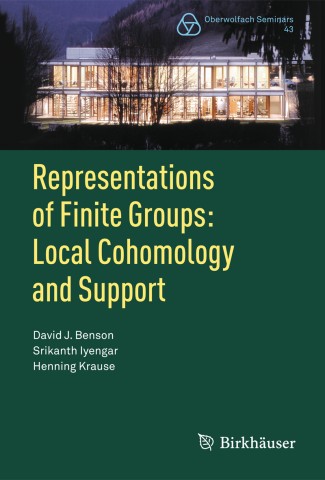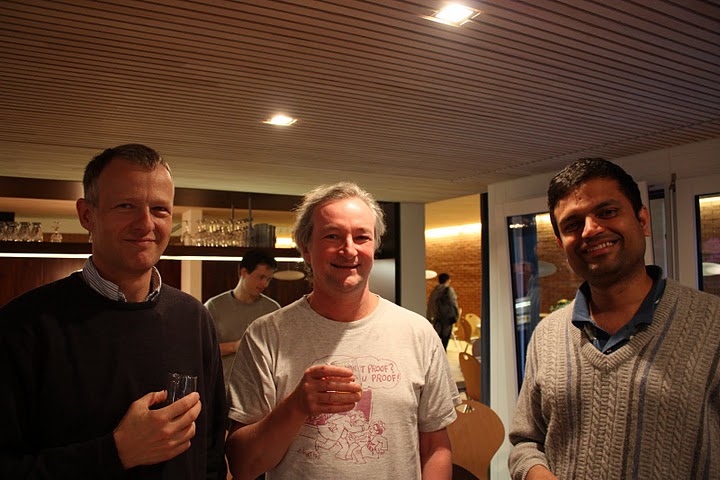

This website provides material for a course at the CIMPA School "Geometric and Homological Methods in the Representation Theory of Associative Algebras and Their Applications" at Medellín, Colombia (June 18-27, 2018), and a similar course for the "Isfahan School on Representations of Algebras" at Isfahan, Iran (April 7-15, 2019).
The notion of support provides a tool for classifying representations of groups and algebras. The course gives an introduction to this rich subject via the the study of triangulated categories with linear actions. The interplay between commutative and non-commutative algebra is an important ingredient, and small examples will be discussed in full detail.
We begin with a simple example. Consider endomorphisms of a vector space. We may view them as representations of the quiver consisting of a single loop, and we classify them using the action of the polynomial ring in one variable. More generally, we attach to each finitely generated module over a commutative noetherian ring its support, which is a subset of the prime ideal spectrum. This yields, by a Theorem of Gabriel [Ga1962], a bijection between Serre subcategories and specialisation closed subsets.
Main reference: [Kr2013].
Can we define the support for representations of finite dimensional algebras? A fairly general approach is due to Snashall and Solberg [SS2004]; it works for Gorenstein algebras and uses the action of the Hochschild cohomology ring on the stable module category.
We discuss the homological theory of modules over Gorenstein algebras. A characteristic feature is the decomposition of the category of finitely generated modules into two orthogonal subcategories which is due to Auslander and Buchweitz [AB1989]: the Gorenstein projective (or maximal Cohen-Macaulay) modules and the modules of finite projective dimension. These subcategories are glued together via certain approximation sequences. The Gorenstein projective modules carry modulo projectives a natural triangulated structure and can be described as quotient of the derived category modulo the subcategory of perfect complexes; this stable category is also known as singularity category of the algebra [Bu1986]. Moreover, the stable category admits a Serre functor.
Main reference: [Kr2018b].
We discuss two fundamental classifications of thick subcategories. The first is Hopkin's classification for the category of perfect complexes over a commutative noetherian ring, which is very much in line with Gabriel's classification of Serre subcategories [Ho1987]. For a finite group and a field of positive characteristic dividing the order of the group, Benson, Carlson and Rickard classified the thick subcategories of the stable module category of a group algebra [BCR1997].
In both cases one uses a notion of support which assigns to each object a closed subset of the prime ideal spectrum of the commutative ring which is acting centrally; it is the underlying commutative ring in the first case and the group cohomology ring in the second case.
The explicit description of all finite dimensional representations of the Klein four group illustrates this classification; it will be discussed in full detail.
Main reference: [BIK2012b].
The two classifications of thick subcategories for perfect complexes and modular group representations can be pushed further. This was pursued by Neeman in the commutative setting [Ne1992], and much later by Benson, Iyengar, and Krause for group representations [BIK2012a]. One obtains classifications of localising subcategories, in the first case for the full derived category of not necessarily finitely generated modules, and in the second case for the full stable module category of a group algebra.
We will discuss the general setting of a compactly generated triangulated category with the central action of a graded commutative noetherian ring. The main tool are local cohomology functors which are obtained from composing Bousfield localisation and colocalisation functors.
Main reference: [BIK2012b].
The derived category of a hereditary algebra admits an explicit description because each complex is quasi-isomorphic to its cohomology. Therefore thick subcategories of the module category correspond bijectively to thick subcategories of the derived category. We discuss a classification of those thick subcategories which are generated by exceptional sequences, using the poset of non-crossing partitions. This is due to Ingalls and Thomas [IT2003] and was later extended by Hubery and Krause [HK2016]. The correspondence maps an exceptional sequence to a product of reflections in the corresponding Weyl group. This yields a vast generalisation of Gabriel's classification of indecomposable representation of quivers of Dynkin type via positive roots [Ga1972].
The derived category of coherent sheaves on a projective line is equivalent to the derived category of the Kronecker algebra, which is the path algebra of the quiver consisting of two parallel arrows. This example demonstrates that we have two approaches towards a classification of thick subcategories that are somewhat complementary: the one via support theory and the one using non-crossing partitions [KS2017]. So we end this lecture with some open problems which are illustrated by this simple example.
Main reference: [Kr2018a].

